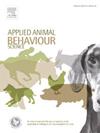猫孢子虫病病变严重程度与行为之间的关联可能表明消极的情绪状态
IF 2.2
2区 农林科学
Q1 AGRICULTURE, DAIRY & ANIMAL SCIENCE
引用次数: 0
摘要
孢子虫病是一种新兴的热带人畜共患病,在世界范围内报告的病例越来越多,影响到猫,通常需要长期隔离治疗。虽然大多数研究都集中在流行病学和药理学方法上,但猫作为有知觉的病人的作用仍未得到充分探索。本研究旨在评估在兽医护理下的猫的行为与孢子虫病治疗时间和病变严重程度之间的关系。在大学兽医诊所传染病隔离病房接受孢子虫病治疗的8只猫分别进行了野外、新物体和未知人体试验。猫在入组时的病变图片被用来通过数字病变评分来评估病变的严重程度和程度(0 =无病变;30 =所有身体部位严重病变)。治疗持续时间(以周为单位)根据猫的临床记录进行评估。通过线性回归评估试验中病变严重程度和治疗持续时间与行为之间的关系。损伤严重程度得分较高的猫在行为测试中探索的象限较少,在所有测试中往往会发出更多的声音。在新物体测试中,损伤严重程度较高的猫需要更长的时间来接近物体。在未知的人类测试中,损伤更严重的猫与不熟悉的人类接触的时间更少。较长的治疗持续时间与接近新目标的延迟时间增加有关,但没有其他行为变量与治疗持续时间有关。损伤得分较高的猫表现出谨慎的行为,表明损伤的严重程度可能会影响它们的反应。这些发现强调,在孢子虫病治疗期间,需要同时考虑疾病和有知觉的患者,因为病变的严重程度和治疗时间似乎会影响猫的行为,这表明猫正在经历消极的情绪状态。本文章由计算机程序翻译,如有差异,请以英文原文为准。
Associations between feline sporotrichosis lesion severity and behaviour may indicate negative emotional states
Sporotrichosis, an emerging tropical zoonosis, is increasingly reported worldwide, affecting cats and often necessitating prolonged isolation for treatment. While most studies focus on epidemiology and pharmacological approaches, the cat's role as a sentient patient remains underexplored. This study aimed to evaluate the associations between the duration of sporotrichosis treatment and lesion severity with the behaviour of cats under veterinary care. Eight cats undergoing sporotrichosis treatment at the university veterinary clinic’s infectious diseases isolation ward were subjected once to open field, novel object, and unknown human tests. Pictures of the cat's lesions at enrolment were used to assess the severity and extent of lesions through a numeric lesion score (0 = no lesion; 30 = severe lesions in all body parts). Treatment duration in weeks was assessed based on the clinical records of the cats. Associations between lesion severity and treatment duration with behaviours in the tests were assessed via linear regression. Cats with higher lesion severity scores explored fewer quadrants in the behavioural tests and tended to vocalise more times across all tests. In the novel object test, cats with higher lesion severity took longer to approach the object. In the unknown human test, cats with more severe lesions spent less time in contact with the unfamiliar human. Longer treatment durations were associated with increased latency to approach the novel object, but no other behavioural variables were linked to treatment duration. Cats with higher lesion scores exhibited cautious behaviours, indicating that lesion severity likely influences their responses. These findings emphasise the need to consider both the disease and the sentient patient during sporotrichosis treatment, as lesion severity and treatment duration appear to impact the cat’s behaviour suggesting that cats are experiencing negative emotional states.
求助全文
通过发布文献求助,成功后即可免费获取论文全文。
去求助
来源期刊

Applied Animal Behaviour Science
农林科学-行为科学
CiteScore
4.40
自引率
21.70%
发文量
191
审稿时长
18.1 weeks
期刊介绍:
This journal publishes relevant information on the behaviour of domesticated and utilized animals.
Topics covered include:
-Behaviour of farm, zoo and laboratory animals in relation to animal management and welfare
-Behaviour of companion animals in relation to behavioural problems, for example, in relation to the training of dogs for different purposes, in relation to behavioural problems
-Studies of the behaviour of wild animals when these studies are relevant from an applied perspective, for example in relation to wildlife management, pest management or nature conservation
-Methodological studies within relevant fields
The principal subjects are farm, companion and laboratory animals, including, of course, poultry. The journal also deals with the following animal subjects:
-Those involved in any farming system, e.g. deer, rabbits and fur-bearing animals
-Those in ANY form of confinement, e.g. zoos, safari parks and other forms of display
-Feral animals, and any animal species which impinge on farming operations, e.g. as causes of loss or damage
-Species used for hunting, recreation etc. may also be considered as acceptable subjects in some instances
-Laboratory animals, if the material relates to their behavioural requirements
 求助内容:
求助内容: 应助结果提醒方式:
应助结果提醒方式:


